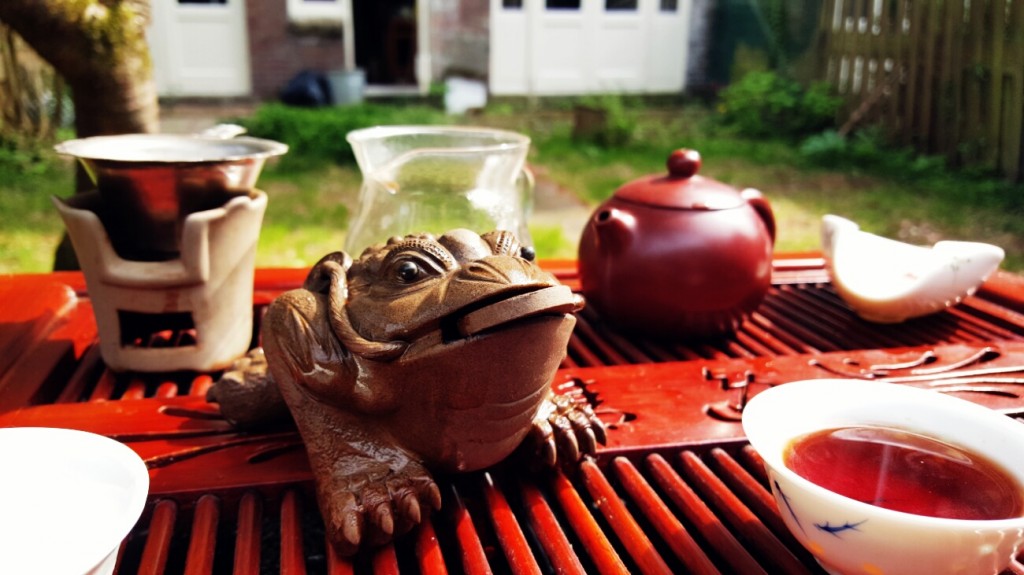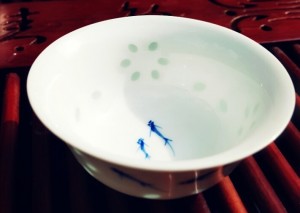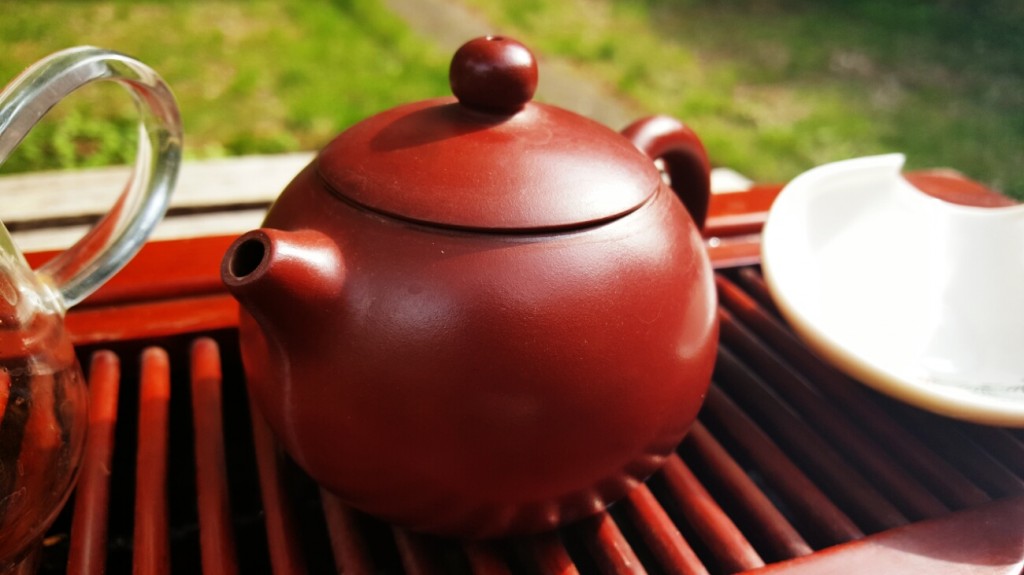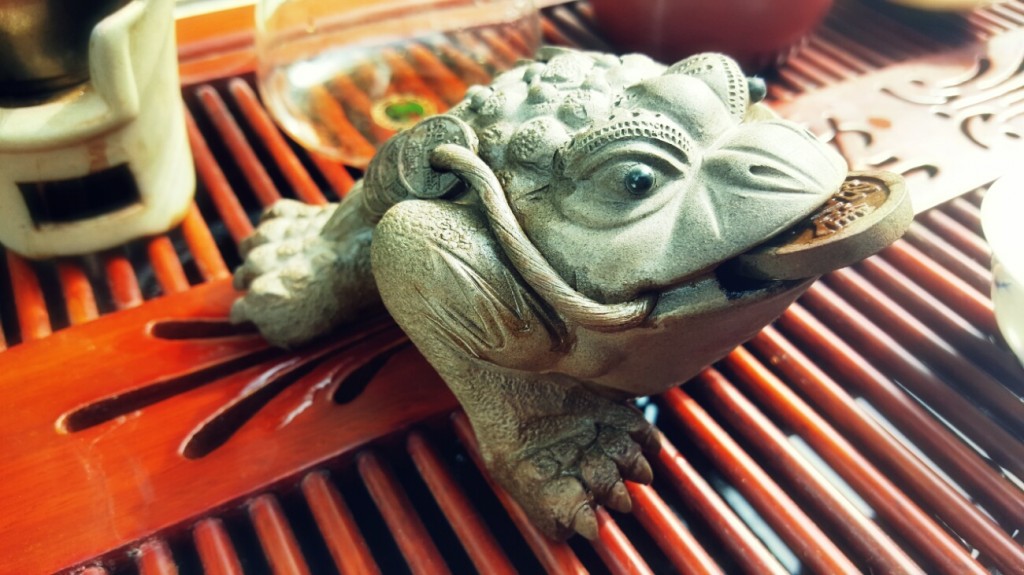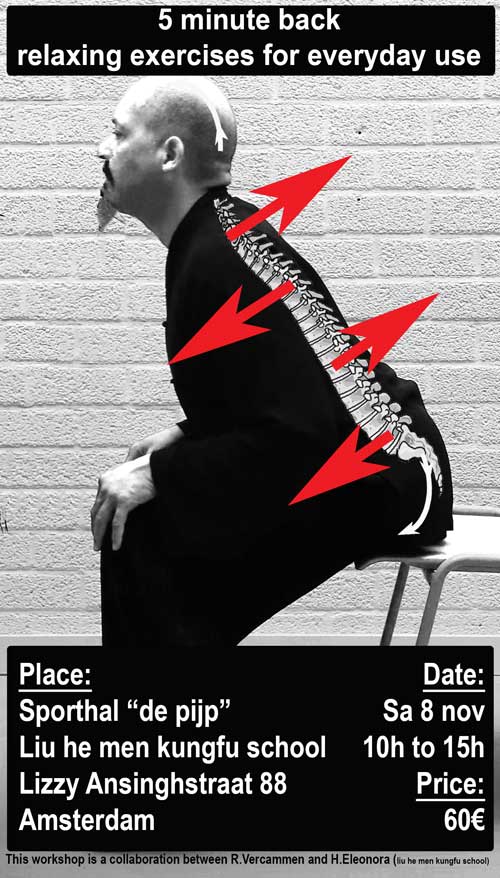Vandaag is het prima weer om in de tuin te ontbijten. Ik mag van geluk spreken dat ik in Amsterdam een tuintje heb met een ‘sweet spot’ in de zon. Op dagen als deze word ik vanzelf vroeg wakker, klaar om mijn training te doen. Meestal begin ik met een korte zittende Qigong oefening waarin ik verschillende delen van mijn lichaam mentaal langsloop. Daarna doe ik een ik serie van stretch en rek oefeningen uit het ‘dao yin yang sheng gong’ systeem. Dat buiten trainen heeft toch echt wel zijn voordelen ten opzichte van binnen trainen en daar gaat dit stukje blog over.
Continue Reading →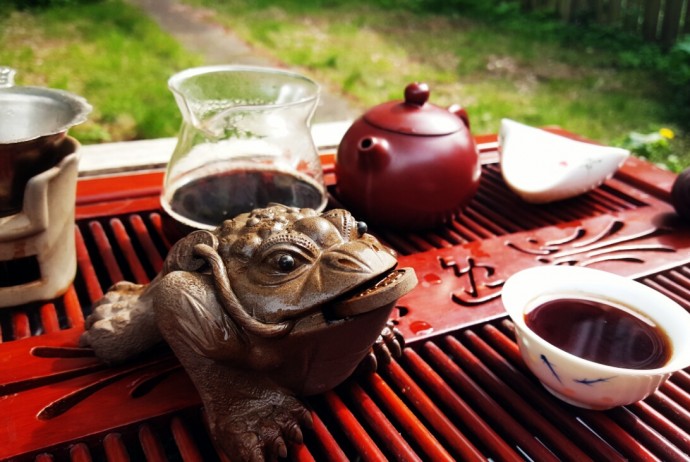
Gōngfūchá: The Gongfu tea ceremony
Today it was the first day that the sun finally came out and actually produced a somewhat enjoyable temperature. Sitting in my garden, after my morning training session, I took out my Gōngfūchá tea set. The first time I learned of this special way of preparing and appreciating tea was with my first real gongfu teacher Mike Martello. This method is very popular within the gongfu circles where tea is also used in special ceremonial rites.
Of course not many people know of this art especially in the west. When we drink tea we often unintentionally throw a bag of tea in some boiling water to quickly drink the tea with our breakfast or so. The Chinese however appreciate tea the way we do wine and even a little bit beyond.
The Gōngfūchá method embodies the holistic view in a way. The tea varieties are numerous with well-known names as dragon well tea (green tea), Pu Erh, oolong, etc. Since good tea is very hard to find in Europe I personally order mine from ebay at this moment. Check out this shop if only to see how many different teas there are. http://stores.ebay.com/Dragon-Tea-House?_rdc=1
The tea is served on a leak trough tray because Gōngfūchá is done while rinsing and over pouring water a great deal of the time. The water is first brewed to the appropriate temperature, which is different for oolong or pu erh.
The tea is carefully inserted in the clay teapot. These teapots are often small and prices for old pots can easily go to 4000euro and higher. But to appreciate tea you don’t have to go that crazy. For 50 to 60 euro you’ll have a nice Yixing teapot. Yixing is a certain kind of clay used to make teapots. Of course also here there are different kinds of clay used to make pots. The tea is supposed to be absorbed slowly by the clay over a long period so you can know by the smell of the pot what tea is normally brewed in it. The clay also adds to the taste of the tea, that’s why you never ever wash a pot with soap. Keep your girlfriend away from your collection!! (joking) I personally use a different pot for every different tea.
After tea is brewed it has to be strained into a pitcher to clear away dust and impurities. The cups are often washed and there are different methods to do that according to the region. In Taiwan for example they don’t touch the tea glasses and they are washed holding them with tweezers. The cups are most of the time very small and good for 3 sips of teas. They are made of very thin porcelain so the tea is quickly drinkable.
On my tea tray you can also see a “Jin Chan” or golden toad which is a Yixing clay statue, resembling the golden toad a mytical figure, over which the excess tea is poured for good fortune and also to prevent the water from splashing when thrown away.
The time is takes to brew a tea is at the same time the pleasure of it. The whole focus is on the taste and the spectacle of color and form. This is a very Eastern idea. Don’t just rush into something but take the time to appreciate the whole process, with the drinking of the tea as the icing on the cake. Brewing like this is very soothing and forces one to calm down. If you have not drank real Chinese tea you certainly have to try it ones. The taste pallet is so much more complex than the teas we are used to; it’s a healthy experience.
If you want to know more about Gōngfūchá than here are some pages to look at:
http://en.wikipedia.org/wiki/Gongfu_tea_ceremony
and some different tea ceremony youtube movies
https://www.youtube.com/playlist?list=PL66530C510AE79AB3
Enjoy!
5 minute back excersises Qigong
Speciale workshop met aandacht voor rugklachten en hoe deze te voorkomen en te verlichting.
Nederland is een koud en vochtig land en zeker in dit seizoen (welke ironisch genoeg het seizoen van de droogte is). In samenwerking met mijn leraar, Shifu H. Eleonora, organiseer ik een workshop speciaal voor onderrug en rugklachten.
We zullen 4 uur trainen met een uurtje pauze.
Inschrijven kan via email: ruudbagua@gmail.com
het adres is: Lizzy Ansinghstraat 88
http://www.liuhemen.nl/
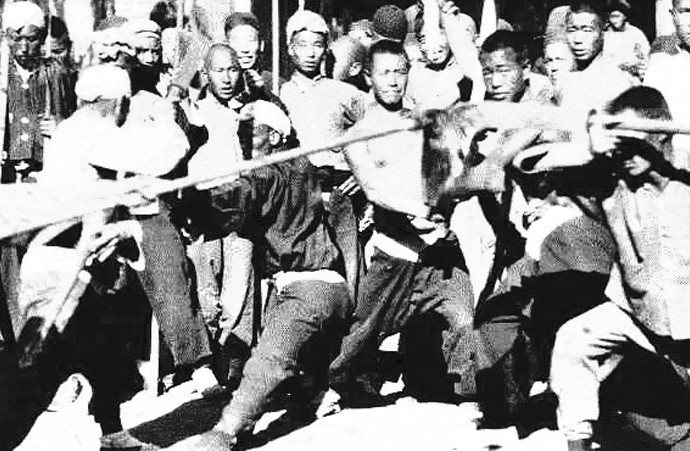
Selfdefence is bliss
Gain more selfrespect while you learn to trust your body and make it stronger.
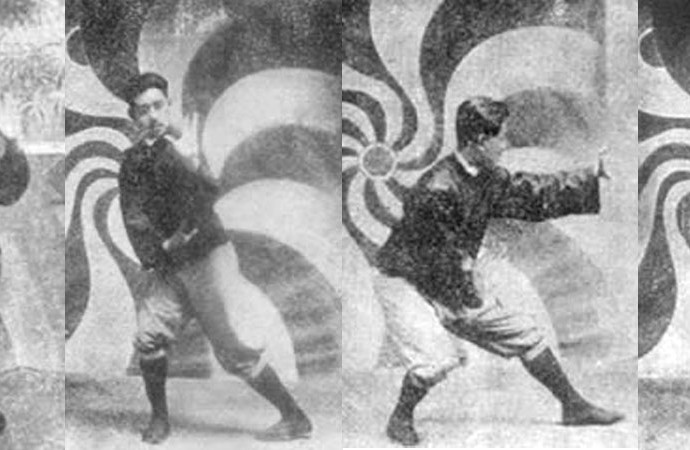
Moving Natural, what stops you?
The power of endless changing, coiling and twisting. Ever evasive to surprise and come in with devastating power.
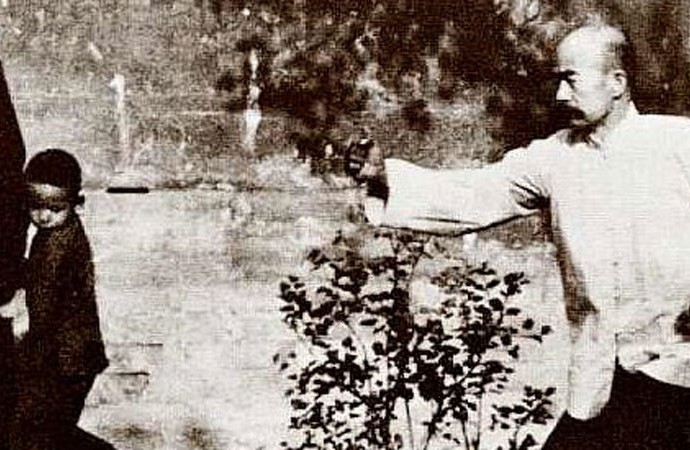
Explosiveness powered by intent
Combining intention with a strong bodily structure is what Xingyiquan is all about. Learn the 5 elements and 12 animals to become strong and healthy.

Understanding Xingyi part II
The Chinese are not a People who give names to something for no reason. Entrusting the core base 5 techniques of your system with the name 5 elements/ Wu xing五行, is not just a philosophical spoof. I believe that, these basics of XingYi can provide a bigger view and insight of oneself, life, than mere self-defense. It will drastically change your way of practice. This is something I like to bring forward in my teaching.
Al ot of people like to play with Wu xing on a very basic level. They’re focus is on the Ke- and Sheng cycle (constructive and destructive cycle). Especially bec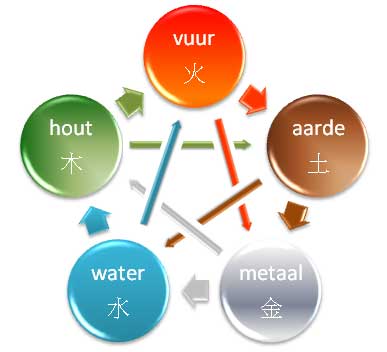 ause XingYi is a martial art the Ke-cycle is emphasized. You can read all kinds of translations for the “Ke” character: destroying, attacking,… .
ause XingYi is a martial art the Ke-cycle is emphasized. You can read all kinds of translations for the “Ke” character: destroying, attacking,… .
To the best of my knowledge and understanding “controlling” is the best translation. The Wood face controls the Earth fase, which in turn controls the Metal fase and so on. Controlling… , more in the sense of making it possible for the other fases to manifest themselves in an orderly, balanced way. In XingYi this manifests itself as Pi Chuan being able to stop/break Beng Chuan and so on. (“Pi” is done like slapping/splitting down with the palm, “Beng” is done like continuous punching forward) These provide easy to understand basic attacking defending idioms.
The former view is, of course, very interesting but when you get stuck on this level of understanding you will not reap the same benefits as someone who takes it a step further.
Wu Xing talks about 5 energies or fases which constitute a whole in which there is a never ending progression of one fase/enegy in to the other. It’s the overall principle of life on this earth and its your basic training in XingYi! By consequence you can understand life better by practicing the language of 5 elements expressed in XingYi. Some understand it through Chinese medicine, some through philosophy… we do it through XingYi: Through physical practice!
Gaining insight in the separate parts can make you understand the whole better. I personally don’t like to see someone playing Wu Xing on a monotone level. These are very different elements who should be preformed differently and I’m not just talking about outward appearance. Remember the translation of “XingYi”; meaning to form/mind boxing, thus connecting your movements with an intention of the mind. The whole intention when you play Pi Chuan should differ from Beng Chuan. Otherwise its all the same. And if these 5 elements are the true building blocks of XingYi and I mean THERE’S JUST 5 of them! Shouldn’t they be at least looked at closely and differently and from as much angles as possible (which is a very Chinese thing to do).
“Remember the translation of “XingYi”; meaning to form/mind boxing, thus connecting your movements with an intention of the mind.”
Now let’s think about the wood fase for example. What could you do to implement the “feel” of this fase to your performance of Beng chuan? To do this it’s interesting to look at what the wood fase represents, what does it have to contribute to the 5 elements as a singularity and as a whole?
You can find plenty information on the attributes on the internet but let’s name a few to get a picture:
• Springtime
• Wind
• Planning ahead
• Frustration/anger
• Liver/gallbladder
• renewal, reawakening and rebirth
• seedlings
• bow and arrow
• flexibility and ability to change necessarily for survival
• upward movement
• …
Now what does this tell you and what is the relation between your practice and the difference in-between the other elements. If the Chinese placed your Beng chuan within the framework of Wu Xing and pertaining to the Wood fase (the Wood fase does not pertain to Beng chuan btw) what link is here to be seen? The key is to see the common principle uniting these loose words and movements.
(You can understand that by looking at XingYi in this way it goes far beyond the word “sport” and that you do not train XingYi but study it!!! It’s a lifetime’s work because understanding is not the same as being able to do it.)
So what do we see as a common principle? There is an element of starting growth from the depth that is unstoppable and this uprising of sudden yang energy shoots straightforward. If you try to stop it it will change its path slightly to progress again. This movement is forward not back. There is also a tension that comes along with this starting from scratch, just as you would watch a bird coming out of an egg. It’s the moment just before the egg gets punctured by the beak and the actual breaking of the egg. The stopping of this inevitable movement creates tension and frustration.
This is very different from the Water fase principle which precedes the Wood fase in the Sheng cycle. How to do the movement? This is something you will have to ask your teacher, words fall short to seeing and feeling…
The bigger forms in XingYi like Wuxing he yi, lian huan, Ba shi, zha shi chui, … all derive their elemental strength out of the basic five elements. Just as the 12 meridians are preceded by the 5 elements in Chinese medicine, you could say that the 12 meridians are a step further, going more in to detail. There is a reason why you first learn 5 elements separate and then bigger forms. You should be able to switch quickly in between the different energies of the 5 elements because the bigger forms are successions of the 5 elements fists. You have to be skilled to identify the 5 elements’ feel in other movements that don’t look the deal but are essentially the same. This will add quality to your form and is proof of diligent study and understanding.
Words are in no way a replacement for practice so the only way to put this text in to use is to practice experience and feel. Enjoy!
If you liked what you read check out the rest of the blog.
Especially understanding XingYi part I
Xingyi wordt in Haarlem en Amsterdam gegeven.
Hier vind je meer info over lestijden, prijzen en locaties.
Ps: Some interesting questions/angles I didn’t address are: what is the relationship between let’s say the Pi chuan and the lung organ who both belong to the summarizing whole of the Metal fase and Why does training Pi chuan in a wrong fashion have a bad effect on the lungs (maybe even digestion?) Maybe for a later blog 😉
Ruud Vercammen is a licensed Acupuncturist and Tuina therapist. He teaches XingYi and BaguaZhang In Amsterdam and Haarlem. You can also find him on Linkedin
Ruud is available for workshops where the link between Chinese callisthenics, medicine, philosophy and daily life will become apparent and helpful for all.
Spijsverteringsproblemen
De lijst van spijsverteringsproblemen en aanverwante kwalen is omvangrijk. Chinees gezien zijn er enkele belangrijke spelers die invloed hebben op de spijsvertering.
Het is belangrijk te begrijpen dat het Aarde element, waartoe de Maag en de Milt behoren, in het centrum van de vijf elementen staat en dat verstoringen in de andere elementen een invloed op deze organen en hun invloedssfeer hebben. (Chinese geneeskunde kent buiten de functie nog andere kenmerken aan de organen toe).
Een voorbeeld:
Tot het hout element behoren de organen: Lever en Galblaas. Het Hout element is zeer vatbaar voor emotie en stress. Situaties zoals eten tijdens vergaderingen of moeders met kinderen die snel een hapje binnensteken tijdens de drukte , kortom eten onder de druk van stress en emoties, zullen een nadelig effect op het verteringsproces hebben. Als het Hout element het Aarde element horizontaal gaat beïnvloeden, krijg je verschillende soorten klachten:
- Zuurbranden en oprispingen
- Hikken, boeren
- Constipatie
- …
Stress, vermoeidheid en burn out:
Er is een reden waarom ik deze drie klachten, stress, vermoeidheid en burn out bij mekaar vernoem. Zij zijn namelijk een cascade van erger wordende klachten. Om inzicht in deze cascade te krijgen is onderstaande beschrijving interessant.
De vecht- of vluchtreactie:
“Een vecht- of vluchtreactie (ook wel vecht-, vlucht- of vriesreactie) is een verdedigingsmechanisme dat bij mensen en dieren optreedt als er acuut gevaar dreigt. De reactie begint met acute hevige angst en stress. Als gevolg hiervan produceert het lichaam grote hoeveelheden adrenaline en cortisol (stresshormonen), de bloeddruk en hartslag gaan omhoog, de spieren worden gespannen, haren komen rechtop te staan (kippenvel), de zintuigen worden scherper (pupillen verwijden, oren staan rechtop) en de pijngevoeligheid daalt naar een zeer laag niveau (endorfinestimulus). Hierdoor is het lichaam voorbereid op een gevecht of om op de vlucht te slaan.
Als het gevaar is geweken, produceert het lichaam endorfine en dopamine om de balans weer te herstellen.”
Bron: http://nl.wikipedia.org/wiki/Vecht-_of_vluchtreactie
Deze reactie is in normale omstandigheden essentieel voor het levensbehoud!
Stress en onze huidige maatschappijdruk:
De druk die wij in ons huidige persoonlijke- en beroepsleven ervaren geeft een soort constante vecht- of vluchtreactie. Al is deze miniem, de druk tot presteren, eindeloze opvolgende deadlines, emoties, … ,zorgen ervoor dat we in een constant sluimerende acuut gevaar situatie leven. Ons lichaam weet niet beter dan constant stresshormoon af te geven, bloeddruk en hartslag op te drijven, spieren te spannen, … . Voor het leren van een tentamen is dat prima maar niet als “standaard instelling”.
In dit Stadium is de prognose normaal gezien heel goed en snel mits aanpassingen gedaan worden in het dagelijkse leven zoals: sport, Taichi, Qigong, Bagua, tao yin. Bewustwording van bestaande patronen speelt ook een grote factor.
Vermoeidheid:
Als we maar lang genoeg doorgaan in bovenstaande situatie raken de grondstoffen en reserves van ons lichaam uitgeput met een grote verscheidenheid aan klachten en vage ongemakjes.
- Slecht slapen (het lichaam geraakt nog meer uitgeput)
- Branderige ogen
- Spijsverteringsproblemen
- Concentratie stoornissen
- Hartkloppingen (verergeren dikwijls de stress nog meer!)
- Nachtzweten
- Droge huid
- …
Dikwijls merk je in dit stadium dat mensen aan vakantie toe zijn maar tijdens of vlak na de vakantie ziek worden. De reden hiervoor is dat wanneer je lichaam dan eindelijk eens kan ontspannen (als dat nog mogelijk is), ziektes en bacteriën gemakkelijk het lichaam kunnen binnendringen omdat je weerstand door de uitputting te laag is. Al deze tekens zijn zouden je moeten vertellen dat je rustig aan moet doen.
In Stadium is de prognose nog steeds goed al moet je wel rekenen op een iets langer behandel termijn gezien de uitputting/ leegte.
Burn out:
Burn out is een van de reacties die ons lichaam heeft als reactie op langdurige uitputting door stress in de breedste zin. Het is een soort nood mechanisme van ons lichaam om levensbehoud.
In Stadium is de prognose nog steeds goed maar je moet wel rekenen op een langer behandeltraject omdat het lichaam leeg is. Die leegte moet zich natuurlijk aanvullen en dat neemt tijd in beslag. Je eigen bewustwording en gedwongen levensaanpassing zijn van uiterst belang. Dit is een genezingstraject dat we samen aangaan.
Waarom Chinese geneeskunde voor deze klachten?:
De Chinese geneeskunde helpt je natuurlijk genezen op het tempo van het lichaam, waar je dan al een tijdje niet naar luisterde. We maken de combinatie; Mind, Body. Dit doen we vanuit de realisatie dat een klacht nooit enkel lichamelijk is. In het geval van Stress en daaruit voortvloeiende klachten is het behandelen en kalmeren van het brein/gemoedstoestand heel belangrijk.
Voor meer informatie kunt U best telefonisch contact opnemen, een reactie op de site achterlaten of mailen.
Nek- en rugpijn
De benen en ons bekken zijn gemaakt om het gewicht van het lichaam te dragen. Echter vandaag de dag zitten we dikwijls meer dan 75% van de dag neer. De wervelkolom en de nek worden daardoor elke dag overmatig belast. Daarnaast bewegen we ook nog eens te weinig.
Verkeerde houding:
Een correcte houding, en aanverwant goed ingestelde werk en thuisomgeving, kan veel klachten voorkomen. We realiseren het ons niet maar ons hoofd weegt om en bij de 10 kilo. Als je elke dag ongeveer 8 u werkt waarbij je hoofd niet juist over je schouders en rug gepositioneerd is, moeten de spieren van de rug en nek dus ook 8u lang 10 kilo tegenhouden.
Die constante stress en spanning op de spieren resulteert in pijn maar op lange termijn ook in een andere spier- en botgroei. Kortom je belandt in een vicieuze cirkel van alsmaar erger wordende klachten. Enkele van de bijkomende klachten zijn.
- Hoofdpijn
- Duizeligheid
- Slechte concentratie
- Uitstralingen naar de armen en benen
- Doodgevoel in de extremiteiten
- Koude
- Oppressie van de borstkas
- Valangst
- Slaapproblemen
- …
Orgaan gerelateerd:
Rugpijn en nekpijn kunnen zoals vele andere klachten Chinees gezien ook vanuit een verstoring van de balans in de organen komen. Denk hierbij aan Lever, Nieren, Darmen en ook aan menstruatieklachten met uitstralende pijn, … .
Trauma:
Een verkeerde beweging is zo gemaakt en gezien de opbouw en taak van de ruggengraat en de nek is het ook logisch dat beide gevoelig zijn voor letsels. Vergeet niet dat een onderliggende disbalans of uitputting van organen de rug ook zwakker kan maken en je dus gevoelig bent voor rug- en nekproblematiek. De meeste mensen die “door de rug gaan” zullen dikwijls ook al meerdere malen last gehad hebben en/of last gaan krijgen.
Chinees gezien zorgt een trauma voor een al dan niet kortstondige stagnatie van doorstroming op de desbetreffende plek. Als de stagnatie blijft kan deze met de tijd ook een leegte op die plek veroorzaken. Je kunt het bekijken als een als een rivier waarvan de stroom door een dam wordt omgezet in een klein beekje. In begin zal het gebied rondom nog even geen schade ondervinden maar uiteindelijk zullen de vissen en planten niet meer gevoed worden. Het gebied voor de dam overstroomt en het gebied achter de dam droogt uit.
Rugpijn heeft nog vele andere oorzaken en de aard en uiting van deze rugpijn zal heel verschillend zijn alsook de behandeling; Acupunctuur, Tuina, cupping, guasha, moxa, …
Voor meer informatie kunt U best telefonisch contact opnemen, een reactie op de site achterlaten of mailen.
